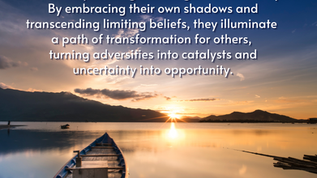"It's not my problem..my people is the problem!"
The ability of an organization's leaders to strike a healthy balance between the expression of their care and concerns throughout the entirety of their actions in leading the life of an organization is at the heart of an organization's capacity to deliver a robust and sustainable performance. It is quite likely that a leader would generate negative repercussions in his entire organization, including a languid mood, distrust, low morale, or even resentment, if he expresses an excessive amount of concerns while displaying a lack of caring through his leadership interactions.

A leader is someone who takes charge of an organization's culture and makes significant contributions to the organization's vitality. After having a typical everyday interaction with a leader, you can get a sense of how that leader has developed the culture of his organization simply by being in the same room with him and picking up on the vibe that he gives off to his followers. Marshall Goldsmith asserted in his masterwork that "what got you here won't get you there," which is a common saying in the business world. He draws attention to the fact that a leader with an excessively strong impulse to educate his people about what is proper has unintentionally produced a culture of disconnection and has firmly imparted a "I'm the boss" kind of attitude to his followers.
Surprisingly, a good number of influential people have been operating from within this blind region without being aware of it. Some people even take great pride in their ability to "point people in the right direction". Therefore, when the people in his organization are sluggish to respond and good individuals leave the organization, there are very few emerging stars that can be identified as the next leaders (external leaders always have to be recruited), bottom-up ideas are nearly unheard of, and errors and patterns of similar problems continue to endure. All of these are signs of having lived in the transparent blind area for an excessively long period of time.
How do you handle a situation like this if you are in a leadership role? You will, without a doubt, feel driven to seek the guidance of an experienced professional. It is possible that you may hear some suggestions involving efforts such as reorganizing, reviewing processes, aligning HR systems, and other similar topics. These are all valid points of view that come from a good place. However, how many of these will actually address the core of the problem in a way that is productive?
If we want to have a conversation that is truly revealing, one that is constructive and one that generates the most viable outcomes, we need to begin by having a dialogue that is candid and that conveys an atmosphere of openness, candor, and flexibility. The role of a leader, as stated by Ram Charan in his book "Execution," is to have a dialogue that is based on the reality of what has transpired in the field and how a leader has contributed to a circumstance he dealt with.
To be able to have this kind of talk, one needs to have tremendous confidence as well as the courage that comes from having the ability to coach someone who is on par with a CEO. Parts of the scenario include questions that question the status quo, questions that move viewpoints, and questions that sidestep the curtain of dialogue that should be avoided.
Some companies choose to rely on their own employees as a resource because they are under the impression that they know more about themselves than external source. If someone who lives within the organization is given the responsibility of initiating or mediating this conversation with the leader, it will be an extremely challenging task, if not an impossible one entirely. The atmosphere of historical discourse and cultural interaction can be a significant barrier to the disclosure of information. If you want to foster the conversation of possibilities, a viable solution could be to find an experienced facilitator who is also independent and has a strong grasp of other cultures and the ability to navigate the dialogues amidst complexity of the challenges in the client’s organizations.
When trying to solve problems or respond to a challenge, it is common for unintended consequences to result in the production of further difficulties. This is the case when we do not or are unable to address the fundamental issues that have led to the problems or challenges in the first place, specifically how the top leader thinks and reacts to situations.
By Leksana TH



















